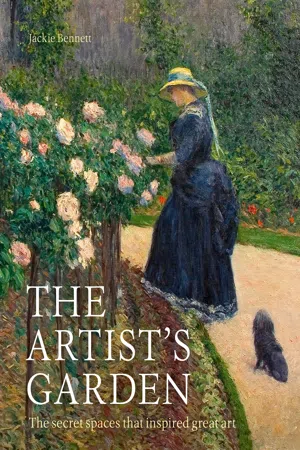
- 224 pages
- English
- ePUB (mobile friendly)
- Available on iOS & Android
About This Book
The Artist's Garden offers an intriguing study into 20 gardens that have inspired and been home to some of the greatest painters of history. The most alluring image of an artist at work is surely one where he or she has come out of their studio, set up their easel on the garden path, pulled on a hat to shade their eyes from the sun and taken their brush and palette in hand. This sumptuously illustrated and fascinating book delves into thestories behind the gardens which inspired some of the most beautiful and important works of art. These gardens not only supplied the inspiration for creative works but also illuminate the professional motivation and private life of the artists themselves – from Cezanne's house in the south of France to Childe Hassam at Celia Thaxter's garden off the coast off Maine. Flowers and gardens have often been the first choice for artists looking for a subject. A garden close to the artist's studio is not only convenient for daily material and ideas, but also has the advantage of changing through the seasons and over time. Claude Monet's Giverny was the catalyst for hundreds of great paintings (by Monet and other artists), each one different from the one before. Sometimes a whole village becomes the focus for a colony of artists as at Gerberoy in Picardy and Skagen on the northernmost tip of Denmark. This book is about the real homes and gardens that inspired these great artists – gardens that can still be visited today. The relationship between artist and garden is a complex one. A few artists, including Pierre Bonnard and his neighbour Monet were keen gardeners, as much in love with their plants as their work, while for others like Sorolla in Madrid, his courtyard home was both a sanctuary and a source of ideas. This book is as unmissable for art lovers as it is for anyone who knows the joy of time spent in gardens, offering an intriguing insight into the lives of these great painters and the gardens which inspired them to their creative heights.
Frequently asked questions
Information
THE ARTIST AT HOME AND AT WORK

Leonardo da Vinci


EARLY PATRONS
Table of contents
- Cover
- Title Page
- Contents
- Introduction
- The Artist at Home and at Work
- The Artists’ Community
- Selected reading
- Visiting details
- Index
- Acknowledgments
- Picture credits
- Copyright